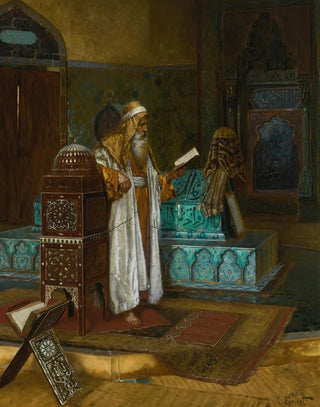Art print | The tomb of Sultan Mehmed I - Rudolf Ernst


View from behind

Frame (optional)
In the vast panorama of art history, some artworks manage to capture the essence of a bygone era while transcending cultural boundaries. "The Tomb of Sultan Mehmet I" by Rudolf Ernst is such an artwork. It evokes not only the magnificence of the Ottoman Empire but also the spiritual depth and artistic heritage that stem from it. Through this depiction, the artist does not merely trace a historical monument; he invites the viewer to enter a universe where beauty and the sacred meet. The scene, rich in detail, seems to vibrate with its own life, revealing the mysteries of a lost era while remaining deeply rooted in the collective imagination.
Style and uniqueness of the work
The uniqueness of this piece lies in Rudolf Ernst's ability to blend realism and lyricism. Every element, from the delicate ornaments of the tomb to the expressions of the depicted characters, is treated with remarkable precision. Light plays a crucial role, subtly illuminating the details while creating an atmosphere that is both solemn and captivating. Ernst, with his inimitable style, manages to give an almost tactile dimension to his painting, inviting the viewer to explore the textures and colors that intertwine. The shades of blue and gold, symbols of imperial grandeur, blend harmoniously, creating a palette that evokes both material richness and spiritual depth of the Ottoman Empire. This painting, in sum, is an ode to beauty and memory, a tribute to the grandeur of a glorious past.
The artist and his influence
Rudolf Ernst, a prominent figure of the 19th century, is often recognized for his ability to capture the Orient with fascinating precision. His work is part of an artistic movement that, although tinged with exoticism, stands out for an authentic pursuit of truth. Ernst traveled across the Ottoman Empire, immersing himself in local cultures, traditions, and landscapes. This journey allowed him to develop a unique perspective on Eastern reality, far from the clichés often conveyed by his contemporaries. His influence extends

Matte finish

View from behind

Frame (optional)
In the vast panorama of art history, some artworks manage to capture the essence of a bygone era while transcending cultural boundaries. "The Tomb of Sultan Mehmet I" by Rudolf Ernst is such an artwork. It evokes not only the magnificence of the Ottoman Empire but also the spiritual depth and artistic heritage that stem from it. Through this depiction, the artist does not merely trace a historical monument; he invites the viewer to enter a universe where beauty and the sacred meet. The scene, rich in detail, seems to vibrate with its own life, revealing the mysteries of a lost era while remaining deeply rooted in the collective imagination.
Style and uniqueness of the work
The uniqueness of this piece lies in Rudolf Ernst's ability to blend realism and lyricism. Every element, from the delicate ornaments of the tomb to the expressions of the depicted characters, is treated with remarkable precision. Light plays a crucial role, subtly illuminating the details while creating an atmosphere that is both solemn and captivating. Ernst, with his inimitable style, manages to give an almost tactile dimension to his painting, inviting the viewer to explore the textures and colors that intertwine. The shades of blue and gold, symbols of imperial grandeur, blend harmoniously, creating a palette that evokes both material richness and spiritual depth of the Ottoman Empire. This painting, in sum, is an ode to beauty and memory, a tribute to the grandeur of a glorious past.
The artist and his influence
Rudolf Ernst, a prominent figure of the 19th century, is often recognized for his ability to capture the Orient with fascinating precision. His work is part of an artistic movement that, although tinged with exoticism, stands out for an authentic pursuit of truth. Ernst traveled across the Ottoman Empire, immersing himself in local cultures, traditions, and landscapes. This journey allowed him to develop a unique perspective on Eastern reality, far from the clichés often conveyed by his contemporaries. His influence extends






